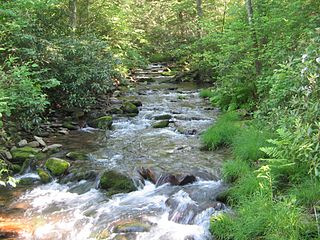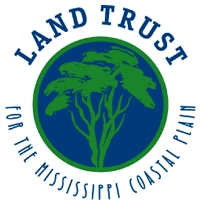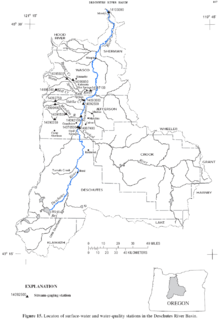Related Research Articles

In the United States, a conservation easement is a power invested in a qualified private land conservation organization or government to constrain, as to a specified land area, the exercise of rights otherwise held by a landowner so as to achieve certain conservation purposes. It is an interest in real property established by agreement between a landowner and land trust or unit of government. The conservation easement "runs with the land", meaning it is applicable to both present and future owners of the land. The grant of conservation easement, as with any real property interest, is part of the chain of title for the property and is normally recorded in local land records.
Land trusts are nonprofit organizations which own and manage land, and sometimes waters. There are three common types of land trust, distinguished from one another by the ways in which they are legally structured and by the purposes for which they are organized and operated:

The Lackawanna River is a 42-mile-long (68 km) tributary of the Susquehanna River in northeastern Pennsylvania in the United States. It flows through a region of the northern Pocono Mountains that was once a center of anthracite coal mining in the United States. It starts in north Wayne County, Pennsylvania and ends in east Luzerne County, Pennsylvania in Duryea, Pennsylvania. The lower reaches of the river flow through the urban areas of Scranton, which grew around its banks in the 19th century as an industrial center. Its name comes from a Lenni Lenape word meaning "stream that forks".

The Western Pennsylvania Conservancy (WPC) is a private nonprofit conservation organization founded in 1932 and headquartered in Pittsburgh, Pennsylvania. WPC has contributed land to 12 state parks and conserved more than a quarter million acres of natural lands. The Conservancy plants and maintains more than 132 gardens in 20 Western Pennsylvania counties, as well as planting thousands of trees through its community forestry program. WPC has protected or restored more than 3,000 miles (4,800 km) of rivers and streams. In 1963, Edgar Kaufmann Jr. entrusted Frank Lloyd Wright's masterwork Fallingwater to the Conservancy. The house was called the most important building of the 20th century by the American Institute of Architects.

White Deer Hole Creek is a 20.5-mile (33.0 km) tributary of the West Branch Susquehanna River in Clinton, Lycoming and Union counties in the U.S. state of Pennsylvania. A part of the Chesapeake Bay drainage basin, the White Deer Hole Creek watershed drains parts of ten townships. The creek flows east in a valley of the Ridge-and-valley Appalachians, through sandstone, limestone, and shale from the Ordovician, Silurian, and Devonian periods.

Bowman Creek is a tributary of the Susquehanna River in Luzerne County and Wyoming County, in Pennsylvania, in the United States. It is approximately 26 miles (42 km) long and flows through Ross Township and Lake Township in Luzerne County and Noxen Township, Monroe Township, and Eaton Township in Wyoming County. The watershed of the creek has an area of 120 square miles (310 km2). The creek is not designated as an impaired waterbody and its pH is close to neutral, although it has experienced some problems with acid rain. It has low concentrations of dissolved solids like calcium. The creek is relatively small in its upper reaches, but by Noxen, its width is 40 to 60 feet. It is also relatively shallow in many reaches. Rock formations in the watershed include the Catskill Formation, the Huntley Mountain Formation, Burgoon Sandstone, the Mauch Chunk Formation, the Pottsville Group, and the Pocono Formation. Soil associations in the creek's watershed include the Wellsboro-Morris-Oquaga association, the Oquaga-Lackawanna-Arnot association, the Mardin-Bath-Volusia association, and the Wyoming-Pope association.
Natural Lands is a non-profit land conservation organization with headquarters in Media, Pennsylvania, dedicated to the management, protection, and conservation of eastern Pennsylvania and southern New Jersey's native forests, fields, streams, and wetlands. The organization owns and manages 44 nature preserves—totaling more than 23,000 acres—located in 13 counties in Pennsylvania and New Jersey. Nineteen of the preserves are open to the public for recreational use; the others have limited visitation due to the presence of sensitive ecosystems or limited facilities.

White Clay Creek State Park is a Delaware state park along White Clay Creek on 3,647 acres (1,476 ha) in New Castle County, near Newark, Delaware in the United States. North of the park is Pennsylvania's White Clay Creek Preserve, and the two were originally operated as bi-state parks to jointly protect the creek, but now they operate separately. The White Clay Creek is federally protected as part of the National Park Service's National Wild and Scenic Rivers System. White Clay Creek State Park offers 37 miles (60 km) of nature and fitness trails which are open to hiking and mountain biking 365 days a year with access at a number of seasonal day-use fee parking lots. Fee season is in effect March 1 - November 30. Fees are $4 for in-state vehicle or $8 for out of state vehicles. Annual passes can be purchased at any DE State Park Office or online. The park also preserves a number of historic structures and operates a nature center. It is part of the Northeastern coastal forests ecoregion.

The Delaware & Lehigh Canal National and State Heritage Corridor (D&L) is a 165-mile (266 km) National Heritage Area in eastern Pennsylvania in the United States. It stretches from north to south, across five counties and over one hundred municipalities. It follows the historic routes of the Lehigh and Susquehanna Railroad, Lehigh Valley Railroad, the Lehigh Navigation, Lehigh Canal, and the Delaware Canal, from Bristol to Wilkes-Barre in the northeastern part of the state. The backbone of the Corridor is the 165-mile (266 km) D&L Trail. The Corridor's mission is to preserve heritage and conserve green space for public use in Bucks, Northampton, Lehigh, Carbon, and Luzerne counties in Pennsylvania. It also operates Hugh Moore Historical Park & Museums, which includes the National Canal Museum.

According to the California Protected Areas Database (CPAD), in the state of California, United States, there are over 14,000 inventoried protected areas administered by public agencies and non-profits. In addition, there are private conservation areas and other easements. They include almost one-third of California's scenic coastline, including coastal wetlands, estuaries, beaches, and dune systems. The California State Parks system alone has 270 units and covers 1.3 million acres (5,300 km2), with over 280 miles (450 km) of coastline, 625 miles (1,006 km) of lake and river frontage, nearly 18,000 campsites, and 3,000 miles (5,000 km) of hiking, biking, and equestrian trails.
Private landowner assistance program (PLAP) is a class of government assistance program available throughout the U.S. for landowners interested in maintaining, developing, improving and protecting wildlife on their property. Each state provides various programs that assist landowners in agriculture, forestry and conserving wildlife habitat. This helps landowners in the practice of good land stewardship and provides multiple benefits to the environment. Some states offer technical assistance which includes:
Conserving Carolina is a non-profit conservation organization working to preserve water and land resources in Western North Carolina. Conserving Carolina was created in July 2017, from a merger of two previously-separate organizations, Carolina Mountain Land Conservancy and Pacolet Area Conservancy. The combined organization maintains a primary office in Hendersonville, NC and a regional office in Columbus, NC.
The Conservation Fund is a U.S. nonprofit organization with a dual charter to pursue environmental preservation and economic development. From 2008–2018, it has placed more than 500,000 acres under conservation management through a program whose goal is to purchase and permanently protect working forests. Since its founding in 1985, the organization has protected land and water in all 50 states, including parks, historic battlefields, and wild areas. The Fund works with community and government leaders, businesses, landowners, conservation nonprofits and other partners to integrate economic and environmental objectives.

The Land Conservancy of San Luis Obispo County (LCSLO) is a local nonprofit organization that has served San Luis Obispo (SLO) County since 1984. Through voluntary and collaborative efforts the LCSLO works to protect and enhance lands having important scenic, agricultural, habitat and cultural values for the benefit of people and wildlife.
Mill Creek is a tributary of the Susquehanna River in Luzerne County, Pennsylvania in the United States. It is 8.7 miles (14.0 km) long. Its watershed is approximately 36 square miles in area. The creek flows through Plains Township, Bear Creek Township, and Wilkes-Barre.

The mission of the Land Trust for the Mississippi Coastal Plain is:
to conserve, promote and protect open spaces and green places of ecological, cultural or scenic significance in the counties of the Mississippi Coastal Plain.
The Land Trust for Tennessee is an American non-profit conservation organization working to protect Tennessee's natural, scenic and historic landscapes and sites. Since 1999, The Land Trust has partnered to conserve more than 131,000 acres (530 km2) of land across 65-plus Tennessee counties.

The Big Sur Land Trust is a private 501(c)(3) non-profit located in Monterey, California, that has played an instrumental role in preserving land in California's Big Sur and Central Coast regions. The trust was the first to conceive of and use the "conservation buyer" method in 1989 by partnering with government and developers to offer tax benefits as an inducement to sell land at below-market rates. As of 2016, it has protected around 40,000 acres (16,187 ha) through acquisition and resale to government agencies. It has added conservation easements to another 17,000 acres (6,880 ha) and has retained ownership of a number of parcels totaling about 4,500 acres (1,821 ha).

The Deschutes Land Trust is a private charitable conservation organization focused on preserving natural landscapes and rivers in the Deschutes River Basin in Oregon, USA. The Trust was formed in 1995, and since then has grown to conserve more than 7,000 hectares of land in over 17 preserves.
References
- ↑ "Our History – North Branch Land Trust". The North Branch Land Trust.
- ↑ "Mission – North Branch Land Trust". The North Branch Land Trust.
- ↑ "Our History – North Branch Land Trust". The North Branch Land Trust.
- ↑ "Mission – North Branch Land Trust". The North Branch Land Trust.
- ↑ "Mission – North Branch Land Trust". The North Branch Land Trust.
- ↑ "Welcome to LexisNexis - Choose Your Path". LexisNexis.
- ↑ The North Branch Land Trust http://www.nblt.org/luzerne-county/bear-creek-camp.
{{cite web}}: Missing or empty|title=(help) - ↑ "EBSCO Publishing Service Selection Page". Ebscohost.
- ↑ Pennsylvania Association of Conservation Districts http://pacd.org/education/pa-watersheds/.
{{cite web}}: Missing or empty|title=(help) - ↑ "Pennsylvania DEP". Pennsylvania Department of Environmental Protection.
- http://www.lexisnexis.com
- http://www.nblt.org/brief-history
- http://citizensvoice.com/news/land-trust-acquisition-to-boost-preservation-1.1619488
- http://pacd.org/education/pa-watersheds/
- http://eds.a.ebscohost.com
- http://www.nblt.org/luzerne-county/bear-creek-camp
- http://www.nblt.org/mission
- http://www.depweb.state.pa.us